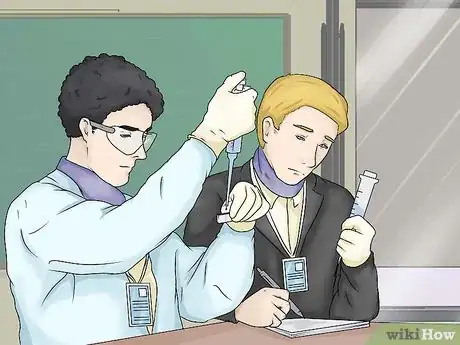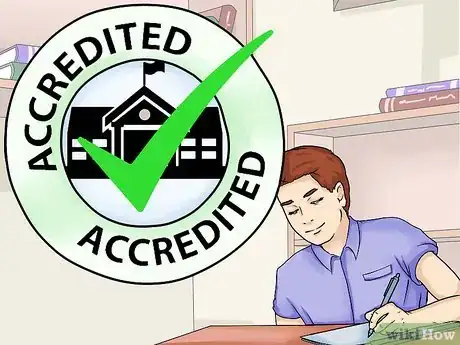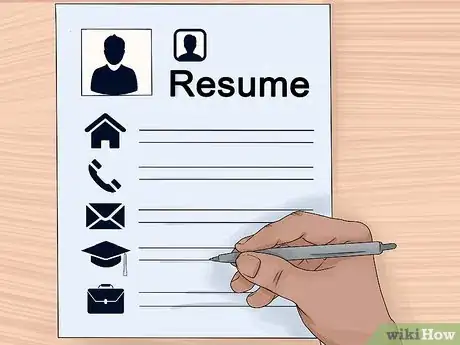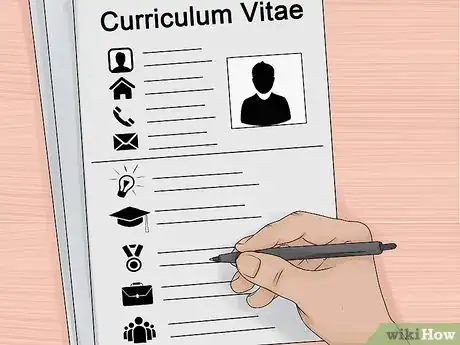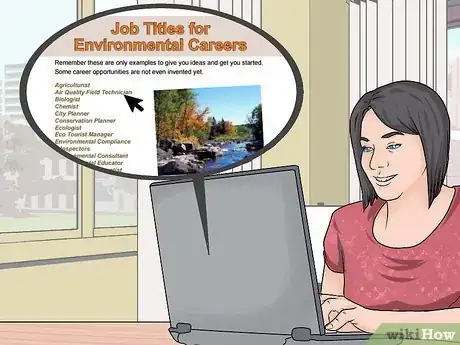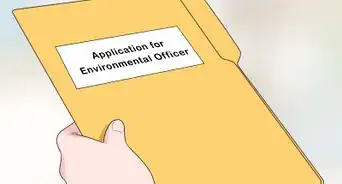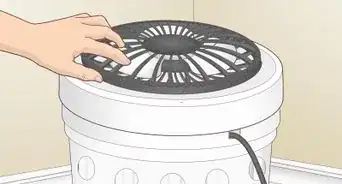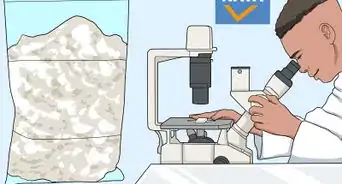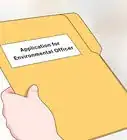This article was co-authored by Adina Zinn, MPA. Adina Zinn is a Certified Career & Life Coach and the Owner of Love Your Work Career and Life Coaching. With five years of experience, she specializes in using a holistic coaching approach to help people achieve their career and life goals. Adina earned a BA from The University of California, Santa Cruz and an MPA from San Francisco State University. She is also a Certified Career Coach through Career Coaches Institute and a Certified Life Coach through The International Coaching Federation.
This article has been viewed 56,360 times.
Environmental scientists perform a variety of studies, including evaluating the air, water and soil for signs of pollution and developing ways to correct environmental problems. They may specialize in agriculture, earth science, education, life science, physical science, and planning/surveying. Environmental scientists often work long hours and may be required to brave the elements to conduct research and collect field samples, or work tirelessly in front of a microscope analyzing samples in a lab setting. However, environmental scientists work in an ever-expanding field with a strong job outlook and competitive pay.[1] If you have a dedication to protecting the environment and enjoy research and problem-solving, a career in environmental science may be right for you.
Steps
Getting an Education
-
1Take relevant high school courses. You'll need at least a bachelor's degree (and may need a master's as well) to work as an environmental scientist, but you can get a head start on your career path by taking relevant courses in high school. Some relevant high school courses to take include:
- laboratory sciences (biology, chemistry, and physics)
- earth science, environmental science, or geology (if available at your school)
- mathematics (algebra, geometry, trigonometry, precalculus, and calculus)
- statistics and computer science
-
2Apply to an accredited college. Most entry-level jobs in environmental science require you to have earned a minimum of a bachelor's degree. Some schools offer a generalized environmental science degree, but most employers will accept a degree in any science-related field.[2]
- Look for programs in either environmental science, or in a scientific field like biology, chemistry, geosciences, or engineering.
- Search online for four-year college programs. You can search by program or by location, if where you study is an important factor.
Advertisement -
3Take an internship. Internships are not necessarily a requirement to graduate or become an environmental scientist, but they provide you with invaluable experience and industry contacts. You can find internships online or by talking to professors and guidance counselors at your school.
- The Student Conservation Association (SCA) provides many internship opportunities in all areas of environmental studies.
- Look for internship opportunities that include working with computer modeling, data analysis, and geographic information systems (GIS). Having experience in these areas of study will help qualify you for many additional jobs, and may give you an advantage when it comes time to apply for jobs.[3]
-
4Earn a bachelor's degree. Whether you major in environmental science or a scientific field, it's important to do well in your studies. Some employers require a master's or doctoral degree, in which case your grades and GPA may affect your eligibility. Make sure you've studied hard, done your best, and pursued any opportunities available outside the classroom.
-
5Consider getting a graduate degree. For many entry-level jobs, you'll only need a bachelor's degree and some amount of relevant experience. However, if you want to advance at your job or become better-qualified for other positions, you may need to earn a master's degree. If you want to teach science classes at either the high school or college levels, you will absolutely need a master's degree, and if you want to perform university research you may need a PhD.[4]
- You can learn about master's and doctoral programs in your area or in other parts of the country by searching online. As you research various graduate school programs, look for statistics like graduation rate, job placement rate, and publications by alumni.
- Be aware that a master's degree in Biology or Environmental Science will generally take two to three years, and a doctoral degree will take considerably longer. However, the number of job opportunities, potential for advancement, and potential for a higher salary that accompany a graduate degree may make the time and money spent on a master's degree or PhD worth it.
Choosing a Career Path
-
1Choose a field to work in. There are six primary career paths within environmental science, though of course there are many other related options, depending on your degree. Each career path involves many individual jobs in a variety of settings. The main career paths are:
- agriculture - involves studying the science of sustainable agriculture and the impact it has on the environment. Common jobs within this career path include agronomist, range manager, and horticulturalist.
- earth science - involves studying and preserving some specialized aspect of an ecosystem. Common jobs within this career path include hydrologist, soil scientist, and climatologist.
- education - involves teaching science and environmental courses to students. While a high school teacher or college professor may be the first jobs that come to mind, there are numerous other possible jobs within this field, including park ranger/interpretive ranger, and environmental law enforcement officer.
- life science - typically involves studying living organisms and their roles within an ecosystem. Common jobs within this path include ecologist, wildlife biologist, and forester.
- physical science - involves studying specific aspects of an ecosystem and ensuring the health and sustainability of that ecosystem. Common jobs include water quality analyst, natural resource manager, and environmental compliance inspector.
- planning and surveying - involves the study of landscapes and ecosystems to determine a sustainable way to build or work within that ecosystem. Common jobs include urban planner, surveyor/cartographer, and turf scientist.
- If you’re not sure what you’d like to specialize in, ask a former professor or employer what field they could see you thriving in.
-
2Determine an ideal type of employer. Depending on the career path and job you're most interested in, you have many options as far as which employers to work for. There are many opportunities at all levels of employment for someone with a degree and experience in environmental science, including:
- private sector - working as a consultant, researcher, or outdoor laborer.
- public sector - working for government agencies, including the Department of Interior or Department of Agriculture, as well as state or city agencies like colleges and universities.
- non-profit organizations - working for environmental advocacy groups like the Environmental Defense Fund, Clean Water Action, Student Conservation Association, or the Sierra Club.
-
3Talk to working professionals. One of the best ways to choose a career path is by talking to people who work across a variety of environmental fields. You should begin with talking to your professors (both current and former) and internship coordinators. However, you can expand outward and talk with researchers, park rangers/environmental law enforcement officers, private environmental consultants, and non-profit organization workers. This will give you a broader understanding of what specific jobs are available, and the pros and cons of those job options.
- If you don't currently know anyone in an environmental field, find someone working in a relevant field near you and reach out to that person. Send a polite, professional email explaining that you're a student or recent graduate trying to gain a better understanding of what career options are available within the environmental field. Or try asking your professors if they have any contacts they can put you in touch with.
Finding Work as an Environmental Scientist
-
1Write a strong resume. Your resume is the first thing a potential employer sees when you apply to a position. It can make or break your chances of getting an interview, so it's important to write a strong, compelling resume that will highlight your best strengths and achievements.
- Put your name and contact information at the top of the page. It should be perfectly clear to an employer who is applying for the job and how to contact that person.[5]
- List your education first, in reverse-chronological order (most recent degree first). If you scored well and/or earned any honors (such as graduating cum laude, etc.), list those honors and your impressive GPA under the degree you earned.
- Include relevant skills and experience to illustrate that you've succeeded in similar endeavors in the past. This helps show an employer that you are capable of meeting the desired skills for that position. If you're fresh out of school and don't have very much experience yet, you may want to include a section on relevant coursework to show the extent of your studies and how that knowledge would translate well to your new career.
- Detail your work experience in reverse-chronological order. You may want to list relevant work experience first, then have a separate section for additional work experience.
-
2Compose a curriculum vitae. A curriculum vitae (CV) is essentially a resume for working in academia. It highlights your academic accomplishments, including any relevant work experience. If you want to work in academia, either as a professor or as a researcher, you will most likely need to compose a CV instead of a resume.
- Include your name and contact information at the top, just as you would for a resume.
- Mention your specific area(s) of academic interest.
- List your education history, including degrees (both earned and in-progress), schools/institutions, major or concentration, and year of graduation. These should be listed in reverse-chronological order.
- List any awards you've earned, either academic or professional, in reverse-chronological order. You should also include any grants you were awarded and any honors you graduated with. Include the dates of those awards/grants/honors and any relevant information that a prospective employer may need to know about each award.
- Detail your publication and presentation history. List any published articles, essays, or books, and any presentations you've given at conferences. If there are a lot of both presentations and publications, you can create a separate section for each.
- Include a section on employment history, listed in reverse-chronological order. You can also include any relevant volunteer work, laboratory or field experiences, and teaching experience, or compose separate sections for each type of work experience if you have an extensive record in each category.
- List any professional or scholarly organizations with which you are a member.
- Include a section for your list of references. This should include any individuals who will be writing letters of recommendation for you, but may include other employers or long-term coworkers as well. Be sure to include each reference's contact information, and make sure it's okay for you to name that person as a reference by checking with him/her ahead of time.[6]
-
3Ask for reference letters. Not every job requires an actual reference letter, but most jobs will ask for a list of references. It's important that you choose carefully when compiling your list of references, as these individuals will have to speak to both your work ethic and your talents/skills.
- If you've participated in any internships, ask your internship leader/supervisor if he or she would be willing to provide you with a job reference.
- Talk to former employers or coworkers from relevant jobs you've worked in the past. Just be sure that you choose employers with whom you ended on good terms.
- If you're fresh out of college, reach out to your favorite professors or teaching assistants. You want someone who can speak to your interest and dedication to the field of environmental studies, so be sure that your teacher/TA will remember you and is willing to provide you with a professional reference.
-
4Apply to environmental jobs. There are many places to search for environmental science jobs. You may want to begin by asking your professors and current/former coworkers if they know of any professional openings that you might be qualified for. If you don't have any network contacts, that's okay - simply search online.
- You can typically search for jobs based on location, job title/career path, agency/employer, salary, or education/experience requirements.
- Look into placement programs for recent graduates. Some prestigious placement programs include Environmental Career Programs (through the Environmental Protection Agency), the Presidential Management Fellow Program, and the Pathways Program.
- Search through career-specific job sites. Some websites to consider include EcoEmploy, Earthworks, Green Dream Jobs, and Greenbiz.
- Follow the application requirements closely, including the deadline for applying. Be sure that your application includes all supplemental materials requested by the employer.
-
5Give a good interview. If your resume and application materials impress an employer, you may be called back for an interview. This is your chance to make a good impression, and you'll want to conduct yourself professionally and competently.
- Dress appropriately. Women should wear a business suit or a professional-looking skirt and blouse with minimal jewelry and cosmetics. Men should wear a two-piece matching suit and tie, with well-groomed hair and facial hair (if relevant - if you do not have facial hair, be sure to be clean-shaved for your interview).
- Research the company before the interview. Know what the company does, what your job would entail, and memorize the interviewer's or interviewers' name(s). Be sure to address the interviewer by the proper title (Dr./Mr./Ms.) and his/her last name (for example, Doctor Ramos).
- Arrive 10 to 15 minutes early. Arriving late shows a careless or disrespectful attitude. If you are running late for reasons outside your control (traffic or a car accident, for example), call the office and let the interviewer or his/her secretary know that you will be late due to unforeseen circumstances. You'll want to apologize for any delays both on the phone and in person when you arrive.
- Bring at least one extra resume to the interview.
- Be confident and avoid using poor language, slang terms, or pause words like "uh" or "um".
- Highlight your achievements and accomplishments, but don't brag.
- Be honest about your academic and professional background. If you're unsure about some aspect of your work experience and the interviewer asks about it, be polite but direct - say something like, "I'm honestly not sure about that. When I worked in that department, my job primarily focused on _____."
- Illustrate the research you've done on the organization you're interviewing with by relating your answers to some aspect of that organization. If the interviewer asks if you've got any questions at the end, you can cater your question(s) to some aspect of the business to show you've taken a serious interest in working for their organization.
References
- ↑ http://www.bls.gov/ooh/life-physical-and-social-science/environmental-scientists-and-specialists.htm
- ↑ http://www.bls.gov/ooh/life-physical-and-social-science/environmental-scientists-and-specialists.htm#tab-4
- ↑ http://www.bls.gov/ooh/life-physical-and-social-science/environmental-scientists-and-specialists.htm#tab-4
- ↑ http://www.bls.gov/ooh/life-physical-and-social-science/environmental-scientists-and-specialists.htm#tab-4
- ↑ http://www.eco.ca/writing-a-resume-specific-to-environmental-work/
- ↑ http://writingcenter.unc.edu/handouts/curricula-vitae-cvs-versus-resumes/
About This Article
To become an environmental scientist, start by taking relevant courses in high school, such as biology, chemistry, and calculus, to get a head start as you continue your eduction. Next, search online to find universities that offer a Bachelor’s degree in environmental science, or a related field like geosciences or engineering. Then, apply for internship opportunities that include working with computer modeling and data analysis. Additionally, consider going to graduate school to give you an advantage when it comes time to apply jobs. For advice on how to choose a career path after graduating with an environmental sciences degree, read on!
